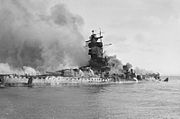SCADTA: Difference between revisions
FoxyOrange (talk | contribs) m add category |
No edit summary |
||
| Line 1: | Line 1: | ||
| ⚫ | |||
{{Infobox Airline |
{{Infobox Airline |
||
|airline = SCADTA<small><br>{{es icon}} Sociedad Colombo Alemana de Transporte Aéreo<br>{{de icon}} Deutsch-Kolumbianische Luftverkehrsgesellschaft<br>{{en icon}} Colombian-German Air Transport Society</small> |
|airline = SCADTA<small><br>{{es icon}} Sociedad Colombo Alemana de Transporte Aéreo<br>{{de icon}} Deutsch-Kolumbianische Luftverkehrsgesellschaft<br>{{en icon}} Colombian-German Air Transport Society</small> |
||
| Line 24: | Line 23: | ||
}} |
}} |
||
The '''Colombian-German Air Transport Society''' ({{lang-es|Sociedad Colombo Alemana de Transporte Aéreo}}, {{lang-de|Deutsch-Kolumbianische Luftverkehrsgesellschaft}}), or '''SCADTA''', was the world's second airline, and the first [[airline]] |
The '''Colombian-German Air Transport Society''' ({{lang-es|Sociedad Colombo Alemana de Transporte Aéreo}}, {{lang-de|Deutsch-Kolumbianische Luftverkehrsgesellschaft}}), or '''SCADTA''', was the world's second airline, and the first [[airline]] in the [[Americas]], operating from 1919 until the end of [[World War II]]. After the war, SCADTA merged with Colombian regional carrier Colombian Air Service ({{lang-es|Servicio Aéreo Colombiano}}), or [[SACO (Colombia)|SACO]]. Together, SCADTA and SACO formed [[Avianca]] - Aerovías Nacionales de Colombia, the Colombian flag-carrier. After Avianca was purchased by Brazilian entrepreneur German Efromovich's company [[Sinergy]] in 2004, the name of the company was changed to Airline of the American Continent (''Aerovías del Continente Americano'') - [[Avianca]]). Avianca still operates to this day. |
||
==History== |
|||
SCADTA started out as a small airmail carrier using [[Junkers (Aircraft)|Junkers]] seaplanes capable of landing on Colombia's [[Magdalena River]], mostly since there were very few suitable landing strips in Colombia at the time. The [[Germany|German]] nationality of SCADTA's ownership motivated the [[United States |
SCADTA started out as a small airmail carrier using [[Junkers (Aircraft)|Junkers]] seaplanes capable of landing on Colombia's [[Magdalena River]], mostly since there were very few suitable landing strips in Colombia at the time. The [[Germany|German]] nationality of SCADTA's ownership motivated the [[United States]] government to subsidize [[Pan American World Airways]]' expansion in Latin America under the [[Herbert Hoover|Hoover administration]]. SCADTA was barred from operating flights to the United States and the [[Panama Canal]], although it continued to maintain a broad route network throughout the [[Andes|Andean]] region. The formation of Pan American-Grace Airways ([[Panagra]]) in the 1930s further eroded SCADTA's position in the market. Prior to World War II, principal shareholder and [[Austria]]n industrialist Peter Paul Von Bauer secretly sold his shares to the [[Pan American World Airways]] in an attempt to protect the airline from acquisition by [[Nazi Germany]]. Following the [[Japan]]ese attack on [[Pearl Harbor]] in late 1941, SCADTA was forced to cease operations and its assets were merged by the [[Colombia]]n government into the state-owned airline, [[SACO (Colombia)|SACO]], forming the modern Colombian national carrier: [[Avianca]]. |
||
==See also== |
|||
| ⚫ | |||
{{Portal|World War II|Colombia}} |
|||
| ⚫ | |||
* [[Colombia during World War II]] |
|||
==External links== |
==External links== |
||
* [http://www.avianca.com/AcercaAvianca/Nuestra+historia/es/Nace-Historia-con-Alas-Tradicion-Experiencia-Compromiso.htm] Scadta/Avianca's history, Avianca's in website. |
* [http://www.avianca.com/AcercaAvianca/Nuestra+historia/es/Nace-Historia-con-Alas-Tradicion-Experiencia-Compromiso.htm] Scadta/Avianca's history, Avianca's in website. |
||
==References== |
|||
| ⚫ | |||
| ⚫ | |||
| ⚫ | |||
{{Latin America during World War II}} |
|||
{{DEFAULTSORT:SCADTA}} |
|||
[[Category:Airlines established in 1919]] |
[[Category:Airlines established in 1919]] |
||
[[Category:Airlines disestablished in 1941]] |
[[Category:Airlines disestablished in 1941]] |
||
[[Category:Avianca |
[[Category:Avianca]] |
||
Revision as of 23:16, 19 August 2013
 | |||||||
| |||||||
| Founded | December 5, 1919 | ||||||
|---|---|---|---|---|---|---|---|
| Ceased operations | 1941 (merged to form Avianca) | ||||||
| Hubs | Ernesto Cortissoz Int'l Airport | ||||||
| Focus cities | El Dorado International Airport | ||||||
| Alliance | Pan Am | ||||||
| Fleet size | See Avianca | ||||||
| Destinations | See Avianca | ||||||
| Parent company | SCADTA | ||||||
| Headquarters | |||||||
| Key people | Ernesto Cortissoz (1st CEO) | ||||||
The Colombian-German Air Transport Society (Spanish: Sociedad Colombo Alemana de Transporte Aéreo, German: Deutsch-Kolumbianische Luftverkehrsgesellschaft), or SCADTA, was the world's second airline, and the first airline in the Americas, operating from 1919 until the end of World War II. After the war, SCADTA merged with Colombian regional carrier Colombian Air Service (Spanish: Servicio Aéreo Colombiano), or SACO. Together, SCADTA and SACO formed Avianca - Aerovías Nacionales de Colombia, the Colombian flag-carrier. After Avianca was purchased by Brazilian entrepreneur German Efromovich's company Sinergy in 2004, the name of the company was changed to Airline of the American Continent (Aerovías del Continente Americano) - Avianca). Avianca still operates to this day.
History
SCADTA started out as a small airmail carrier using Junkers seaplanes capable of landing on Colombia's Magdalena River, mostly since there were very few suitable landing strips in Colombia at the time. The German nationality of SCADTA's ownership motivated the United States government to subsidize Pan American World Airways' expansion in Latin America under the Hoover administration. SCADTA was barred from operating flights to the United States and the Panama Canal, although it continued to maintain a broad route network throughout the Andean region. The formation of Pan American-Grace Airways (Panagra) in the 1930s further eroded SCADTA's position in the market. Prior to World War II, principal shareholder and Austrian industrialist Peter Paul Von Bauer secretly sold his shares to the Pan American World Airways in an attempt to protect the airline from acquisition by Nazi Germany. Following the Japanese attack on Pearl Harbor in late 1941, SCADTA was forced to cease operations and its assets were merged by the Colombian government into the state-owned airline, SACO, forming the modern Colombian national carrier: Avianca.
See also
External links
- [1] Scadta/Avianca's history, Avianca's in website.

